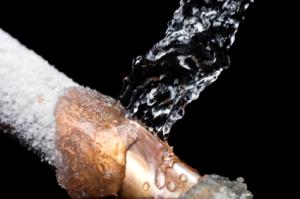
Being prepared and informed may help you to avoid the messy and often expensive issue of frozen pipes. The American Red Cross provides information and suggestions around how to prevent water pipes in the home from freezing, and how to thaw them if they do freeze.
Why Pipe Freezing is a Problem
Water has a unique property in that it expands as it freezes. This expansion puts tremendous pressure on whatever is containing it, including metal or plastic pipes. No matter the "strength" of a container, expanding water can cause pipes to break. Pipes that freeze most frequently are those that are exposed to severe cold, like outdoor hose bibs, swimming pool supply lines, water sprinkler lines, and water supply pipes in unheated interior areas like basements and crawl spaces, attics, garages, or kitchen cabinets. Pipes that run against exterior walls that have little or no insulation are also subject to freezing.
Preventing Frozen Pipes
Before the onset of cold weather, prevent freezing of these water supply lines and pipes by following these recommendations:
-Drain water from swimming pool and water sprinkler supply lines following manufacturer's or installer's directions. Do not put antifreeze in these lines unless directed. Antifreeze is environmentally harmful, and is dangerous to humans, pets, wildlife, and landscaping.
-Remove, drain, and store hoses used outdoors. Close inside valves supplying outdoor hose bibs. Open the outside hose bibs to allow water to drain. - Keep the outside valve open so that any water remaining in the pipe can expand without causing the pipe to break.
-Check around the home for other areas where water supply lines are located in unheated areas. Look in the basement, crawl space, attic, garage, and under kitchen and bathroom cabinets. Both hot and cold water pipes in these areas should be insulated.
-Consider installing specific products made to insulate water pipes like a "pipe sleeve" or installing UL-listed "heat tape," "heat cable," or similar materials on exposed water pipes. Newspaper can provide some degree of insulation and protection to exposed pipes – even ¼” of newspaper can provide significant protection in areas that usually do not have frequent or prolonged temperatures below freezing.
During Cold Weather, Take Preventative Action
-Keep garage doors closed if there are water supply lines in the garage.
-Open kitchen and bathroom cabinet doors to allow warmer air to circulate around the plumbing. Be sure to move any harmful cleaners and household chemicals up out of the reach of children.
-When the weather is very cold outside, let the cold water drip from the faucet served by exposed pipes. Running water through the pipe - even at a trickle helps prevent pipes from freezing.
-Keep the thermostat set to the same temperature both during the day and at night. By temporarily suspending the use of lower nighttime temperatures, you may incur a higher heating bill, but you can prevent a much more costly repair job if pipes freeze and burst.
-If you will be going away during cold weather, leave the heat on in your home, set to a temperature no lower than 55° F.
To Thaw Frozen Pipes
-If you turn on a faucet and only a trickle comes out, suspect a frozen pipe. Likely places for frozen pipes include against exterior walls or where your water service enters your home through the foundation.
-Keep the faucet open. As you treat the frozen pipe and the frozen area begins to melt, water will begin to flow through the frozen area. Running water through the pipe will help melt ice in the pipe.
-Apply heat to the section of pipe using an electric heating pad wrapped around the pipe, an electric hair dryer, a portable space heater (kept away from flammable materials), or by wrapping pipes with towels soaked in hot water. Do not use a blowtorch, kerosene or propane heater, charcoal stove, or other open flame device.
-Apply heat until full water pressure is restored. If you are unable to locate the frozen area, if the frozen area is not accessible, or if you can not thaw the pipe, call a licensed plumber.
-Check all other faucets in your home to find out if you have additional frozen pipes. If one pipe freezes, others may freeze, too.
Future Protection
-Consider relocating exposed pipes to provide increased protection from freezing.
-Pipes can be relocated by a professional if the home is remodeled.
-Add insulation to attics, basements and crawl spaces. Insulation will maintain higher temperatures in these areas.
-For more information, please contact a licensed plumber or building professional.
-Winter weather can be hard on all of us. It can be particularly difficult on our pets that rely on us for their wellbeing, especially for outdoor dogs and cats. -To help keep your entire family safe and warm, the American Red Cross has winter safety reminders for both you and your pets.
Pet Safety in the Winter
-If possible, bring your pets inside during cold winter weather. Move other animals or livestock to sheltered areas and make sure they have access to non-frozen drinking water.
-If the animals are outside, make sure their access to food and water is not blocked by snow drifts, ice or other obstacles.
The following tips on winter pet safety are provided by the Humane Society of the United States:
-If pets cannot come indoors, make sure they are protected by a dry, draft-free enclosure large enough to allow them to sit and lie down, but small enough to hold in the pet’s body heat. Raise the floor a few inches off the ground and cover it with cedar shavings or straw. Turn the enclosure away from the wind and cover the doorway with waterproof burlap or heavy plastic.
-Salt and other chemicals used to melt snow and ice can irritate a pet’s paws. Wipe their paws with a damp towel before your pet licks them and irritates their mouth.
-Antifreeze is a deadly poison. Wipe up spills and store antifreeze out of reach.















